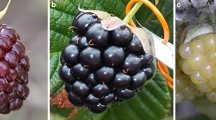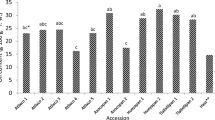Abstract
The worldwide consumption of blueberries has increased due to their potential health effects. They contain micronutrients, various phytochemicals and anti-oxidant pigments, represented especially by anthocyanins. In addition to these, carotenoids and fatty acids are also present. The aim of this study was the identification and quantification of carotenoids (by HPLC) and fatty acids (by GC with flame ionisation detection) in two bilberry genotypes (Wild 1 and 2) and three cultivars (BlueCrop, Elliot, and Duke). The main carotenoids identified were lutein, β-cryptoxanthin, and β-carotene, with the average total carotenoid content of 266 μg per 100 g of fruit. The ratio of saturated fatty acids (SFAs) to polyunsaturated fatty acids (PUFAs) was 0.098 for Wild 1 and 0.11 for Wild 2 genotypes and ranged from 0.14 to 0.28 for cultivars. The main fatty acids identified were linoleic (18:2) and linolenic (18:3) acids in all the samples analysed. In Vaccinium myrtillus the amount of carotenoids and fatty acids was higher than in Vaccinium corymbosum species.
Similar content being viewed by others
References
Aidi Wannes, W., Mhamdi, B., Sriti, J., & Marzouk, B. (2010). Glycerolipid and fatty acids distribution in pericarp, seed and whole fruit oils of Myrtus communis var. italica. Industrial Crops and Products, 31, 77–83. DOI:10.1016/j.indcrop.2009.09.006.
Angerer, P., & von Schacky, C. (2000). n-3 Polyunsaturated fatty acids and the cardiovascular system. Current Opinion in Lipidology, 11, 57–63.
Bere, E. (2007). Wild berries: a good source of omega-3. European Journal of Clinical Nutrition, 61, 431–433. DOI:10.1038/sj.ejcn.1602512.
Breithaupt, D. E., & Schwack, W. (2000). Determination of free and bound carotenoids in paprika (Capsicum annuum L.) by LC/MS. European Food Research and Technology, 211, 52–55. DOI: 10.1007/s002170050588.
Buratti, S., Pellegrini, N., Brenna, O. V., & Mannino, S. (2001). Rapid electrochemical method for the evaluation of the antioxidant power of some lipophilic food extracts. Journal of Agricultural and Food Chemistry, 49, 5136–5141. DOI:10.1021/jf010731y.
Cakir, A. (2004). Essential oil and fatty acids composition of the fruits of Hippophae rhamnoides L. (Sea Buckthorn) and Myrtus communis L. from Turkey. Biochemical Systematics and Ecology, 32, 809–816. DOI: 10.1016/j.bse.2003.11.010.
Folch, J., Lees, M., & Sloane Stanley, G. H. (1957). A simple method for the isolation and purification of total lipids from animal tissues. Journal of Biological Chemistry, 226, 497–509.
Garzón, G. A., Narváez, C. E., Riedl, K. M., & Schwartz, S. J. (2010). Chemical composition, anthocyanins, nonanthocyanin phenolics and antioxidant activity of wild bilberry (Vaccinium meridionale Swartz) from Colombia. Food Chemistry, 122, 980–986. DOI: 10.1016/j.foodchem.2010.03.017.
Giovanelli, G., & Buratti, S. (2009). Comparison of polyphenolic composition and antioxidant activity of wild Italian blueberries and some cultivated varieties. Food Chemistry, 112, 903–908. DOI: 10.1016/j.foodchem.2008.06.066.
Iso, H., Sato, S., Umemura, U., Kudo, M., Koike, K., Kitamura, A., Imano, H., Okamura, T., Naito, Y., & Shimamoto, T. (2002). Linoleic acid, other fatty acids, and the risk of stroke. Stroke, 33, 2086–2093. DOI: 10.1161/01.str.0000023890.25066.50.
Jellin, J. M., Gregory, P. J., Batz, F., & Hitchens, K. (2005). Pharmacist’s letter/prescriber’s letter natural medicines comprehensive database (7th ed., pp. 2239). Stockton, CA, USA: Therapeutic Research Faculty.
Koca, I., & Karadeniz, B. (2009). Antioxidant properties of blackberry and blueberry fruits grown in the Black Sea Region of Turkey. Scientia Horticulturae, 121, 447–450. DOI:10.1016/j.scienta.2009.03.015.
Kraft, T. F. B., Schmidt, B. M., Yousef, G. G., Knight, C. T. G., Cuendet, M., Kang, Y. H., Pezzuto, J. M., Seigler, D. S., & Lila, M. A. (2005). Chemopreventive potential of wild lowbush blueberry fruits in multiple stages of carcinogenesis. Journal of Food Science, 70, S159–S166. DOI:10.1111/j.1365-2621.2005.tb07151.x.
Krinsky, N. I., & Johnson, E. J. (2005). Carotenoid actions and their relation to health and disease. Molecular Aspects of Medicine, 26, 459–516. DOI: 10.1016/j.mam.2005.10.001.
Marinova, D., & Ribarova, F. (2007). HPLC determination of carotenoids in Bulgarian berries. Journal of Food Composition and Analysis, 20, 370–374. DOI: 10.1016/j.jfca.2006.09.007.
Martineau, L. C., Couture, A., Spoor, D., Benhaddou-Andaloussi, A., Harris, C., Meddah, B., Leduc, C., Burt, A., Vuong, T., Le, P. M., Prentki, M., Bennett, S. A., Arnason, J. T., & Haddad, P. S. (2006). Anti-diabetic properties of the Canadian lowbush blueberry Vaccinium angustifolium Ait. Phytomedicine, 13, 612–623. DOI: 10.1016/j.phymed.2006.08.005.
Mazza, G., & Cottrell, T. (2008). Carotenoids and cyanogenic glucosides in Saskatoon berries (Amelanchier alnifolia Nutt.). Journal of Food Composition and Analysis, 21, 249–254. DOI: 10.1016/j.jfca.2007.11.003.
Moreira, A. B., Visentainer, J. V., de Souza, N. E., & Matsushita, M. (2001). Fatty acids profile and cholesterol contents of three Brazilian Brycon freshwater fishes. Journal of Food Composition and Analysis, 14, 565–574. DOI:10.1006/jfca.2001.1025.
Neto, C. C. (2007). Cranberry and blueberry: Evidence for protective effects against cancer and vascular diseases. Molecular Nutrition & Food Research, 51, 652–664. DOI:10.1002/mnfr.200600279.
Risérus, U., Willett, W. C., & Hu, F. B. (2009). Dietary fats and prevention of type 2 diabetes. Progress in Lipid Research, 48, 44–51. DOI: 10.1016/j.plipres.2008.10.002.
Taruscio, T. G., Barney, D. L., & Exon, J. (2004). Content and profile of flavanoid and phenolic acid compounds in conjunction with the antioxidant capacity for a variety of northwest Vaccinium berries. Journal of Agricultural and Food Chemistry, 52, 3169–3176. DOI: 10.1021/jf0307595.
Trevithick, J. R., & Mitton, K. P. (1999). Antioxidants and diseases of the eye. In A. M. Papas (Ed.), Antioxidant status, diet, nutrition, and health (Part 6, Chapter 24, pp. 545–566). Boca Raton, FL, USA: CRC Press.
Viljanen, K., Sundberg, S., Ohshima, T., & Heinonen, M. (2002). Carotenoids as antioxidants to prevent photooxidation. European Journal Lipid Science and Technology, 104, 353–359. DOI: 10.1002/1438-9312(200206)104:6<353::AIDEJLT353>3.0.CO;2-5.
Wu, X., Beecher, G. R., Holden, J. M., Haytowitz, D. B., Gebhardt, S. E., & Prior, R. L. (2006). Concentrations of anthocyanins in common foods in the United States and estimation of normal consumption. Journal of Agricultural and Food Chemistry, 54, 4069–4075. DOI: 10.1021/jf060300l.
Yang, B., Ahotupa, M., Määttä, P., & Kallio, H. (2011). Composition and antioxidative activities of supercritical CO2-extracted oils from seeds and soft parts of northern berries. Food Research International, 44, 2009–2017. DOI:10.1016/j.foodres.2011.02.025.
You, Q., Wang, B., Chen, F., Huang, Z., Wang, X., & Luo, P. G. (2011). Comparison of anthocyanins and phenolics in organically and conventionally grown blueberries in selected cultivars. Food Chemistry, 125, 201–208. DOI:10.1016/j.foodchem.2010.08.063.
Author information
Authors and Affiliations
Corresponding author
Rights and permissions
About this article
Cite this article
Bunea, A., Rugină, D., Pintea, A. et al. Carotenoid and fatty acid profiles of bilberries and cultivated blueberries from Romania. Chem. Pap. 66, 935–939 (2012). https://doi.org/10.2478/s11696-012-0162-2
Received:
Revised:
Accepted:
Published:
Issue Date:
DOI: https://doi.org/10.2478/s11696-012-0162-2




